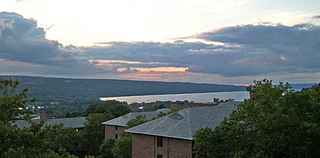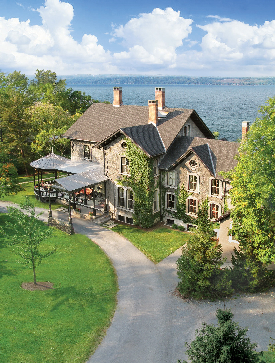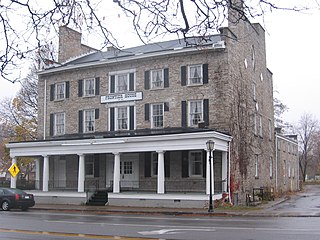
Cayuga Lake (,,) is the longest of central New York's glacial Finger Lakes, and is the second largest in surface area and second largest in volume. It is just under 39 miles (63 km) long. Its average width is 1.7 miles (2.8 km), and it is 3.5 mi wide (5.6 km) at its widest point, near Aurora. It is approximately 435 ft deep (133 m) at its deepest point, and has over 95 miles (153 km) of shoreline.

The Erie Canal is a historic canal in upstate New York that runs east–west between the Hudson River and Lake Erie. Completed in 1825, the canal was the first navigable waterway connecting the Atlantic Ocean to the Great Lakes, vastly reducing the costs of transporting people and goods across the Appalachians. In effect, the canal accelerated the settlement of the Great Lakes region, the westward expansion of the United States, and the economic ascendancy of New York State. It has been called "The Nation's First Superhighway."

The Finger Lakes are a group of eleven long, narrow, roughly north–south lakes located south of Lake Ontario in an area called the Finger Lakes region in New York, in the United States. This region straddles the northern and transitional edge, known as the Finger Lakes Uplands and Gorges ecoregion, of the Northern Allegheny Plateau and the Ontario Lowlands ecoregion of the Great Lakes Lowlands.

Wayne County is a county in the U.S. state of New York. As of the 2020 Census, the population was 91,283. The county seat is Lyons. The name honors General Anthony Wayne, an American Revolutionary War hero and American statesman.

Aurora, or Aurora-on-Cayuga, is a village and college town in the town of Ledyard, Cayuga County, New York, United States, on the shore of Cayuga Lake. The village had a population of 724 at the 2010 census.

Ledyard is a town in Cayuga County, New York, United States. The population was 1,654 at the 2020 census. The name of the town is from General Benjamin Ledyard, an early settler of the town. Ledyard is on the western edge of the county and is southwest of Auburn.

East Aurora is a village in Erie County, New York, United States, southeast of Buffalo. It lies in the eastern half of the town of Aurora. The village population was 5,998 per the 2020 census. It is part of the Buffalo–Niagara Falls Metropolitan Statistical Area. In 2015, East Aurora was rated the third-best town to raise a family in New York State by Niche. According to the National Council of Home Safety and Security, it is also among the safest places to live in New York State.

Lancaster is a village in Erie County, New York, United States. As of the 2010 census, the village population was 10,352. It is part of the Buffalo–Niagara Falls Metropolitan Statistical Area.

Seneca Falls is a town in Seneca County, New York, United States. The population was 8,942 at the 2020 census.

The Cayuga–Seneca Canal is a canal in New York, United States. It is now part of the New York State Canal System.

Edwin Barber Morgan was an entrepreneur and politician from the Finger Lakes region of western New York. He was the first president of Wells Fargo & Company, founder of the United States Express Company, and director of American Express Company. He was elected to the United States House of Representatives from New York and served for three terms.

The E. B. Morgan House at 431 Main Street, Aurora, New York, was designed in the Italianate style by New York architect Joseph C. Wells for Edwin Barber Morgan, a wealthy entrepreneur and U.S. Congressman. Built between 1857 and 1858, the mansion expressed the new wealth of businessmen in Central New York. Their innovative companies had operations extending to California and the South. The mansion is a contributing property within the Aurora Village–Wells College Historic District, listed in 1980 on the National Register of Historic Places.
The historic village of Aurora, Cayuga County, New York, rises on a hill above the eastern shore of Cayuga Lake. The village was named by Captain Benjamin Ledyard, who settled there in 1793, in the post-Revolutionary development of the Finger Lakes region. Up until the mid-nineteenth century, Aurora played an important part in the history of Central New York.
William Henry Miller (1848–1922) was an American architect based in Ithaca, New York.

Frontier House is considered the "crown jewel" of Lewiston's historic district and one of the most historic landmarks in Western New York. In the early 1800s it was known as the finest hotel in America, west of Albany. It has been home to several Niagara County businessmen and honored guests. The building has been on the National Register of Historic Places listings in Niagara County, New York since 1974. It has served as a hotel, private home, a fine dining restaurant, museum, and a fast food establishment (McDonald's). It is found in Western New York, about ten minutes from Niagara Falls.

The Elmendorph Inn, is the oldest building in the village of Red Hook, New York, United States. It is located at the north corner of North Broadway and Cherry Street, a block north of the junction of Route 9 and NY 199.

Aurora Steam Grist Mill was a historic grist mill located in Aurora, Cayuga County, New York. It was a monolithic, 3+1⁄2-story rectangular stone structure built on the shore of Lake Cayuga. It was one of the first mills built west of the Hudson River to be powered by steam. In 1974, the building's roof collapsed due to neglect and plans were to restore it for use as a community center. It was largely intact until 1992, when Wells College began to demolish it in order to build a dock behind the Aurora Inn.

The Holderness Inn is a former 19th century hotel building on United States Route 3 in Holderness, New Hampshire. Built in 1895–96, it is the only such building standing in the Squam Lake area, from a period when there were a significant number of resort hotels around the lake. The building was listed on the National Register of Historic Places in 1984. It is now owned by the Squam Lakes Natural Science Center, and is open seasonally as an art gallery and craft showroom.
The Brooks Lake Lodge, also known as the Brooks Lake Hotel and Diamond G Ranch, as well as the Two-Gwo-Tee Inn, is a recreational retreat in Fremont County, Wyoming near Dubois in the upper Wind River valley. The complex was built in 1922 to accommodate travelers coming to Yellowstone National Park on U.S. Route 287 from central Wyoming. The buildings are mainly of log construction with Craftsman style detailing.

Historic Hotels of America is a program of the National Trust for Historic Preservation that was founded in 1989 with 32 charter members; the program accepts nominations and identifies hotels that have maintained their authenticity, sense of place, and architectural integrity. In 2015, the program included over 260 members in 44 states, including the District of Columbia, Puerto Rico, and the U.S. Virgin Islands. In 2022, the program includes 273 hotels. This article lists current and former member hotels.























